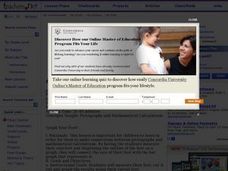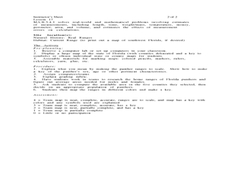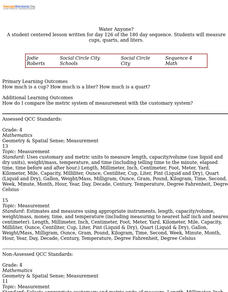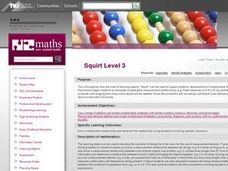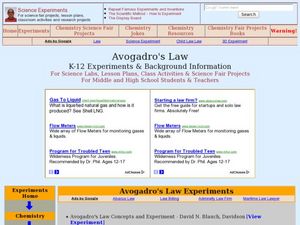Curated OER
Traveling to Japan: Which Way Do We Go?
Fourth graders explore the different types of ways to measure the distance between Florida and Japan.
Curated OER
String of Fish
Fourth graders research a Florida fish to determine its length. They display this information on two index cards, which are cut to the shape of the head and the tail and attached to a string that they measure and cut to the correct...
Curated OER
Graph Your Foot!
Students measure their own foot and place the outline on a graph. They make connections between the size of their foot and the bar graph that represents it.
Curated OER
Powers of 10
Young scholars explore universe, and examine how big it really is and how scientists measure the distances or sizes of things by estimating sizes of different objects and reading and writing numbers in scientific notations.
Curated OER
A Cosmic Cafeteria
Students indentify and differentiate between transit and surface food systems. Students measure energy that is released by various foods. Students compare and contrast cooking with solar energy on earth and what they might have learned...
Curated OER
Efficiency Means Getting More for Less
Students measure water and make predictions about efficiency.
Curated OER
Barrels, Casks and other Curvy Containers: Math, Geomety, Art
Young scholars construct a barrel or other curvy container and then estimate and gauge its volume.
Curated OER
Home on the Range
Young scholars use maps and mathematics to determine the appropriate panther population in a given area. In this Florida ecology lesson, students research the area requirements of male and female panther and use a map to help calculate...
Curated OER
Relationships and Functions
Fifth graders describe patterns as relations and functions. In this patterning instructional activity, 5th graders analyze and continue patterns. Students understand how patterns relate to relations and functions.
Curated OER
How Close Is Our Estimate?
Fifth graders estimate perimeter, area, and volume. They measure perimeter and area using nonstandard units of measurement. Students add and subtract non-standard units of measurement. They add mixed numbers and simplify the sum.
Curated OER
Micropipette and the Metric System
Students practice measuring the correct volume using micropipette. In this biology lesson, students determine the correct micropipette tip to use when transferring fluid. They convert metric volume from one unit to another.
Curated OER
Double or More
Students practice cooking by following recipe instructions. In this measuring lesson, students read food recipes and collect the materials needed to make one batch, then double the recipe to create twice as much food....
Curated OER
Our Solar System and Seasons
Sixth graders investigate the relative diameters of planets and distances between them and the cause for seasons on Earth using the 5-E Learning Model. They appreciate the size and distances involved with objects in the real universe....
Curated OER
Introducing Particles
Pupils predict what is going to happen using prior knowledge being prepared to alter a view when faced with new evidence. They then accurately measure and record liquid volumes realizing that liquids and granular solids have similarities...
Curated OER
What Do Concentrations Mean?
Pupils investigate the concept of climate gases and practice using the appropriate measurement terms. The lesson includes information that is used by the teacher to conduct class discussion or as a source of background for students.
Curated OER
Perimeter and Area of Similar Figures
Students explore the relationships between similar figures. In this relationships between similar figures lesson, students discuss relationships between perimeter, circumference, area, surface area, and volume of similar figures through...
Curated OER
Lung Limit
Students determine their lung capacity by completing a science experiment with a bottle of water. In this lung science lesson, students discuss the lungs' purpose. Students complete an experiment to determine their lung capacity using a...
Curated OER
Optional Laboratory: Calculating Board Footage in a Tree
Middle schoolers work together to complete an experiment calculating the amount of board footage in a tree. They record their data and answer questions at the end of the lesson. They create their own hypothesis as well.
Curated OER
Squirt Level 3
Students use the instructional activity, "Squirt", to support students' development of multiplicative thinking. Squirt encourages students to anticipate multiplicative measurement relationships, e.g. three measures of A fit in B, by...
Curated OER
Avogadro's Law
Students study Avogadro's law and what it means in science. In this gaseous lesson students complete an Avogadro's law experiment.
Curated OER
What is a Pico?
Students label objects in their classroom based on mass and volume using the metric system. They examine the relationship between the numerical value and the corresponding metric unit.
Curated OER
Using Multiplication to Solve Word Problems
Young scholars explore math functions by solving word problems in class. For this multiplication lesson, students utilize colored cubes and base blocks to visualize multiplication problems. Young scholars identify the multiplication...
Curated OER
Discovering Pi
Fourth graders are introduced and experiment with the concept of pi. Using this information, they discover the relationship between the circumference and diameter of circles. In groups, they practice measuring the circumference of...


